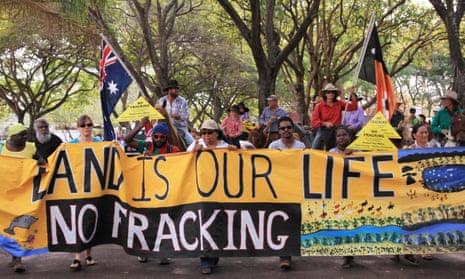The Northern Territory government has lifted a ban on hydraulic fracturing of onshore gas that will open up more than half of the territory’s land mass to the controversial practice.
The first exploration fracking by petroleum companies is expected to occur early next year after the implementation of a regulatory regime and new laws, which the government insists will be strict.
The issue has sharply divided territorians, many of whom believe fracking threatens water supplies, but the chief minister, Michael Gunner, said on Tuesday the industry would create jobs.
Q&AWhat is fracking?
Show
Fracking, or hydraulic fracturing, is a way of extracting natural gas from shale rock formations that are often deep underground. It involves pumping water, chemicals and usually sand underground at high pressure to fracture shale – hence the name – and release the gas trapped within to be collected back at the surface.
The technology has transformed the US energy landscape in the last decade, owing to the combination of high-volume fracking – 1.5m gallons of water per well, on average – and the relatively modern ability to drill horizontally into shale after a vertical well has been drilled.
In England, the government placed a moratorium on fracking in November 2019 after protests, legal challenges and planning rejections. A year earlier, the energy company Cuadrilla was forced to stop work at its Preston New Road site in Lancashire twice in four days due to minor earthquakes occurring while it was fracking. The tremors breached a seismic threshold imposed after fracking caused minor earthquakes at a nearby Cuadrilla site in 2011. In March 2019 the high court ruled that the government's fracking guidelines were unlawful because they had failed to sufficiently consider scientific evidence against fracking.
An independent report handed down by Justice Rachel Pepper last month found the risks associated with hydraulic fracturing of gas deposits could be managed and regulated.
Gunner said the government had accepted all 135 of the inquiry’s recommendations, including about no-go zones.
Fracking will be allowed in around 51% of the NT.
— Daniel Fitzgerald (@danielpfitz) April 17, 2018
Here's the NT gov's map of proposed no-go areas: pic.twitter.com/j29FuyuQJu
“Forty-nine per cent of the Territory will be ‘frack-free’, including in national parks, conservation areas, Indigenous protected areas, towns, residential and strategic assets, and areas of high cultural, environmental or tourism value,” he said.
“We promised an independent, scientific inquiry after which we would either ban fracking or allow it in highly regulated circumstances in tightly prescribed areas.
“We have kept our promise. We have accepted the key finding of the report – that if all the recommendations are implemented the risk from fracking can be reduced to an acceptable level.”
In the rest of the NT, which measures 1.42m sq kms, strict laws and regulations would protect areas and the independent Environment Protection Authority and environment minister would sign off on any fracking.
Environmental groups and scientists have pressed the Labor government to keep the fracking moratorium it introduced, arguing it would adversely affect water, land and public health. The federal government has urged the NT government to allow the economic exploitation of its gas resources.
Naomi Hogan of Lock the Gate said the government’s decision was “shameful” and the result of “bullying” from the gas industry and federal government.
“This is a slap in the face for all of the Territorians who have stood up and opposed fracking to protect their livelihoods in tourism, agriculture, pastoralism and fishing,” she said.
“Justice Pepper’s report included 135 recommendations and identified serious information gaps.
“Lifting the moratorium before studies are done demonstrates a risky ‘frack and see’ approach, which has been heavily influenced by the gas industry.”
The Australia Institute’s research director, Roderick Campbell, said the decision to allow fracking would have a huge impact on Australia’s carbon emissions and would wipe out emissions savings from the Territory government’s 50% renewables target “one hundred fold”.
“According to the inquiry, fracking will lead to an increase of Australia’s emissions annually by between almost 5% to 6.6%. On top of that, the inquiry acknowledged that many more emissions could be produced overseas, potentially equivalent to 18% of Australia’s emissions every year.
“This is a huge cost for such meagre economic gains. The inquiry also found that the most likely outcome was that few jobs would be created and little revenue raised for the Northern Territory.”
The national director of the Seed Indigenous Youth Climate Network, Amelia Telford, said the government had betrayed Territorians.
“There is not one place in the world where fracking hasn’t ended badly,” she said. “The Gunner government has made a grossly irresponsible decision today in allowing gas companies to act on plans for polluting fracking gasfields across the NT.”

Comments (…)
Sign in or create your Guardian account to join the discussion